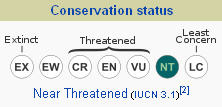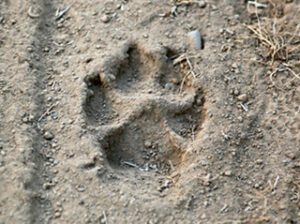Leopard (Panthera pardus)
The elegant, powerfully built leopard has a long body, relatively short legs and a broad head. Its tawny coat is covered with dark, irregular circles called “rosettes.” Leopards come in a wide variety of coat colors, from a light buff or tawny in warmer, dryer areas to a dark shade in deep forests. The spots, or rosettes, are circular in East African leopards but square in southern African leopards.
Size
- Height: about 28 inches at the shoulder
- Length: 5-8 feet
- Weight: 60-210 lbs
Lifespan
- Six or eight years of age, with a few reaching beyond ten.
- Up to 21 years in captivity
Java’s spot; rosettes
Reproduction
- Mating Season: No defined mating season
- Gestation: 90-105 days
- Litter Size: 2-3 cubs
- Cub Rearing: Usually 2 to 3 cubs are born in caves, hollow trees, holes in the ground, or any suitable, sheltered place. The mother leopard moves her cubs to a new shelter every two or three days, carrying them one at a time in her mouth. Leopard mothers groom their cubs by licking and nibbling at them, and they groom each other and their mother. The cubs stop suckling and start eating meat after about 3 months: they are led to the kill to eat until about 10 months, when they join the mother on the hunt. Cubs become independent after a year, although siblings often remain together for a few more months, and some cubs do remain with their mothers for almost two years. After cubs have become independent, affectionate reunions between mother and cubs can still occur.
Range
Diet
Behavior/Habitat
Leopards have a very wide habitat tolerance. They generally occur in rainforests, areas with rocky hills, mountain ranges or temperate forest, but can even occur in semi-desert, where they frequent watercourses and rocky outcrops. In arid regions they are independent of water, deriving sufficient water from the bodies of their prey, as well as tsamma melons, but throughout their range they will drink if water is available. Leopards are solitary creatures and predominately nocturnal. Each individual has a home range that overlaps with its neighbors; the male’s range is much larger and generally overlaps with those of several females. Leopards continually move about their territory, seldom staying in an area for more than two or three days at a time. Ranges are marked with urine and claw marks and leopards announce their presence to other leopards with a rasping cough. Leopards also growl and roar.


Population/Status
Because of their widespread range, there are many subspecies
IUCN: 8 subspecies endangered CITES: Appendix I
Threats
The leopard’s adaptability to both warm and cold climates has helped them survive the loss of habitat caused by increasing human settlement. However, leopards have long been preyed upon by man. Their soft, beautiful fur has been used for clothing. The tail, claws and whiskers of the leopard are popular as fetishes. In some areas farmers try to exterminate them, while in others leopards are considered symbols of wisdom…
Interesting Facts
- The most secretive and elusive of the large carnivores, the leopard is also the shrewdest.
- Pound for pound, it is the strongest of the large cats and capable of killing prey larger than itself.
- To prevent other predators from taking their food, leopards store their larger kills in trees where they can feed on them in relative safety.
- Black leopards are not a separate species or subspecies. The melanistic variation is the result of a genetic mutation.
- Black leopards also have spots.
- The term “black panther” means a large, black cat and is most commonly used in reference to black leopards and black jaguars.
- The leopard’s range is the most widespread of any cat.
- Leopards must compete for food and shelter with other large predators such as lions, tigers, spotted hyenas, and both African and Asiatic wild dogs.
The world does not pay for what a person knows. But it pays for what a person does with what he knows.
~Laurence Lee

Primary Sources:
African Wildlife Foundation
EcoTravel
Wikipedia







